Category Archives for Portrait Painting Challenge
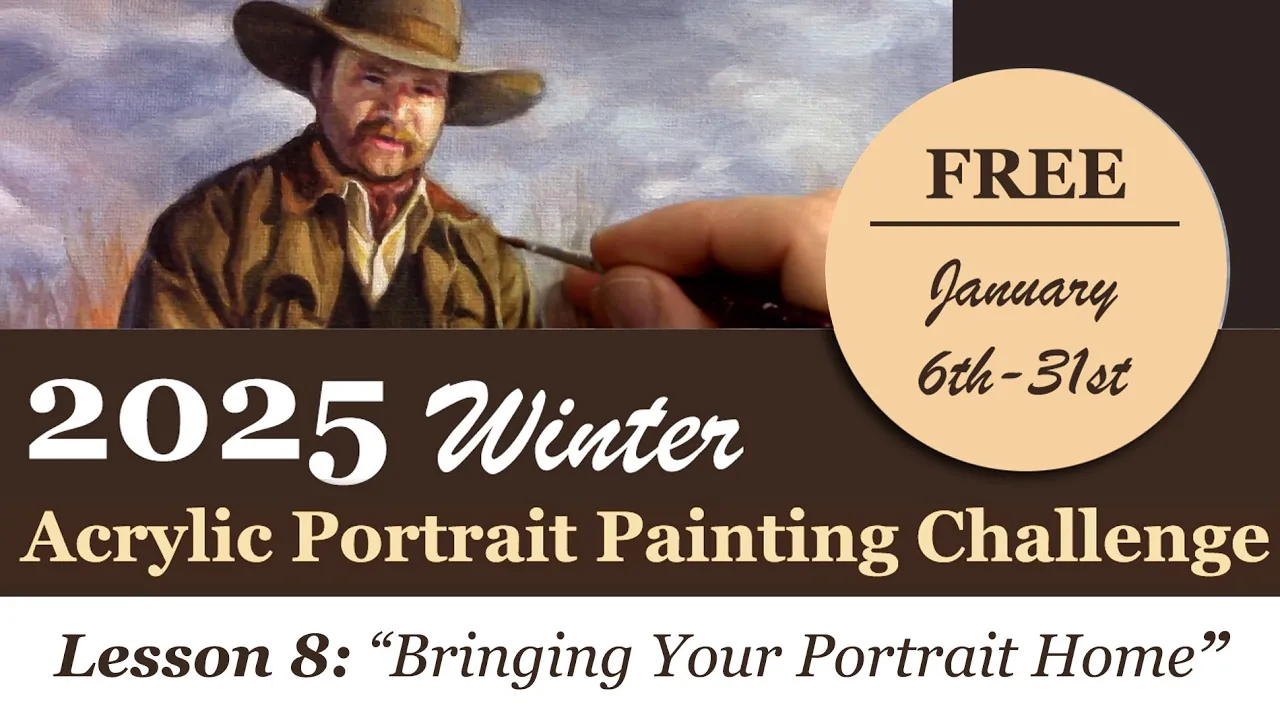
2025 Winter Acrylic Painting Challenge, Lesson 8 Bringing Your Portrait Home
Master the final touches: Bring your acrylic portrait to life with precision and confidence
Congratulations! You’ve made it to the final stage of your acrylic portrait. This is where all the hard work comes together, and your painting truly comes to life. In Lesson 8: Bringing Your Portrait Home, we will focus on refining details, sharpening edges, and adding those final highlights that make your portrait stand out.
It’s tempting to keep working indefinitely, but knowing when to stop is just as important as knowing how to start. By the end of this lesson, you’ll feel confident that your painting is complete, ready to be signed, and displayed with pride.
Step 1: Assess Your Progress
Before making any final touches, take a step back and evaluate your portrait. Ask yourself:
✔ Are the proportions and facial features balanced?
✔ Is the contrast strong enough to create depth?
✔ Do the highlights and shadows define the form effectively?
✔ Are there any unresolved areas that need attention?
If you notice anything that feels off, now is the time to make minor adjustments.
Step 2: Refining Edges and Enhancing Contrast
One of the most effective ways to bring realism to your portrait is by sharpening edges and boosting contrast.
Techniques for Crisp Edges:
- Use a small round brush with slightly thinned paint for clean, sharp lines.
- Define important areas like the jawline, nose bridge, and lips with subtle refinements.
- Blur unnecessary details in background elements to enhance depth and focus.
Boosting Contrast for Depth:
- Deepen shadows with a mix of raw umber and alizarine crimson for warmth.
- Brighten highlights using titanium white with a touch of yellow ochre for natural skin tones.
- Adjust mid-tones to create smooth transitions between light and shadow.
These small changes will make a significant difference in the overall impact of your portrait.
Step 3: Adding Final Highlights
To make your portrait pop, strategic highlights should be applied.
Where to Place Highlights:
✔ The tip of the nose and cheekbones
✔ The upper eyelids and brow ridge
✔ The edges of the lips and chin
✔ The light-catching areas of clothing or accessories
Using a dry brush technique with minimal paint can help you create soft, natural highlights without overpowering the painting.
Step 4: Knowing When to Stop
It’s easy to overwork a painting, but at some point, you must decide it’s finished. A few signs that your portrait is complete:
✔ The main subject stands out against the background.
✔ The details are refined but not overly complicated.
✔ The colors and contrast look balanced.
✔ You feel satisfied when viewing your work from a distance.
If you can check off these points, it’s time to bring your portrait home and move on to the final step—signing your artwork!
Step 5: Signing Your Painting
A signature is the finishing touch that makes your work official.
Tips for Signing Your Acrylic Painting:
✔ Use a fine brush or acrylic paint pen for precision.
✔ Place your signature in a subtle but visible area (bottom right or left corner).
✔ Keep it small and unobtrusive so it does not distract from the portrait.
✔ Use a color that complements but contrasts slightly with the background.
Once signed, your painting is officially complete!
Celebrate Your Progress!
Completing a portrait is a huge achievement! Whether you’re keeping it for yourself, gifting it, or selling it, take a moment to appreciate your hard work.
If you’ve participated in the 2025 Winter Acrylic Painting Challenge, share your final piece with the community and celebrate your growth as an artist. Remember each finished portrait is a stepping stone to even greater artistic success.
📢 Did you enjoy this challenge? Sign up for the next one and keep improving your portrait painting skills! 🎨✨
FAQs: Bringing Your Portrait Home
1. How do I know when my painting is finished?
If the details, contrast, and composition feel balanced, and you no longer see major issues, it’s time to stop. Overworking a painting can reduce its realism.
2. Should I varnish my painting after finishing?
Yes! A protective varnish will enhance colors and provide longevity. Use a gloss, satin, or matte finish, depending on your preference.
3. How can I fix mistakes in the final stages?
For minor errors, gently layer paint over the area with a dry brush. If needed, use a soft wet cloth to lift fresh paint before it dries.
4. What’s the best way to display my finished portrait?
Frame your painting with a simple, elegant border or display it on a stretched canvas for a professional look.
2025 Winter Acrylic Portrait Painting Challenge Series
2025 Winter Acrylic Portrait Painting Challenge: Steps to Get Started
2025 Winter Acrylic Portrait Challenge Pre-Lesson: Gathering Your Supplies
2025 Winter Acrylic Portrait Challenge, Lesson 1: Prepping Your Canvas for the Portrait
2025 Winter Acrylic Painting Challenge, Lesson 2: Sketching Your Portrait Accurately
2025 Winter Acrylic Painting Challenge, Lesson 3: Sealing in Your Sketch
2025 Winter Acrylic Painting Challenge, Lesson 4: Beginning Your Portrait with Glazes
2025 Winter Acrylic Painting Challenge, Lesson 5: Building Up Color and Contrast
2025 Winter Acrylic Painting Challenge,Bonus Video: Increasing Contrast
2025 Winter Acrylic Painting Challenge, Lesson 6 Shading and Color Nuances
2025 Winter Acrylic Painting Challenge, Lesson 7 Creating Realism in Your Portrait
2025 Winter Acrylic Painting Challenge, BONUS Video:Adjusting Colors and Details
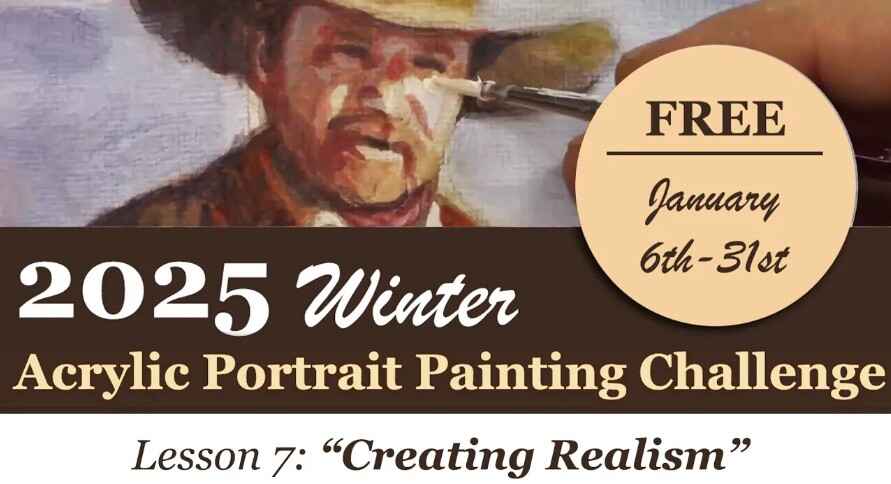
2025 Winter Acrylic Painting Challenge, Lesson 7 Creating Realism in Your Portrait
Bringing your portrait to life with realistic detail
Painting a portrait that looks lifelike requires careful attention to shading, contrast, and color blending. In this lesson of the 2025 Winter Acrylic Painting Challenge, we will focus creating realism in your portrait on refining details, adjusting highlights and shadows, and building realistic skin tones using the glazing technique. If you want to take your portrait to the next level, mastering these techniques will make all the difference.
Step-by-Step Process for Creating Realism in Your Portrait
1. Refining Facial Features with Subtle Adjustments
The face is the focal point of any portrait. In this step, we will:
- Deepen the shadows to define the contours of the face.
- Add warm highlights to create a sense of volume.
- Adjust color transitions for smoother blending.
To start, a detailed brush is used to apply a translucent glaze of raw umber dark and ultramarine blue over the shadowed areas. A touch of alizarine crimson is then added to neutralize any harshness.
2. Enhancing Skin Tones for Natural Depth
Acrylic glazing allows for gradual tone building. The following color mixes are applied in thin layers:
- Warm tones: A combination of burnt sienna, raw sienna, and napthol red is used for rich skin undertones.
- Cool tones: A glaze of ultramarine blue and titanium white is added for reflective highlights.
- Midtones: A mix of organic orange and Indian yellow is applied to balance the transitions.
Each layer is blended using a size 2 round brush to create smooth gradations, ensuring the portrait has a lifelike appearance.
3. Strengthening Contrast for Increased Realism
Realism depends on well-executed contrast. By reinforcing the darkest areas and refining highlights, the portrait gains a three-dimensional look.
- The shadows under the hat brim, on the sides of the face, and within the beard are darkened using raw umber dark mixed with matte medium.
- The reflected light from the snow is captured by adding a cooler highlight using titanium white and ultramarine blue.
Applying these techniques ensures that the light and shadows interact naturally, making the subject appear more lifelike.
Tips & Techniques for Creating Realism in Your Portrait
✅ Layer Thinly – Avoid thick applications. Multiple thin glazes create depth.
✅ Use Color Temperature Correctly – Warm tones advance, cool tones recede.
✅ Refine Gradients – Blend shadows and highlights smoothly to avoid harsh transitions.
✅ Observe Reference Photos – Study how light interacts with skin, clothing, and surrounding elements.
✅ Step Back & Assess – Viewing your painting from a distance helps spot necessary adjustments.
Bringing realism to your acrylic portrait requires patience and careful layering. By focusing on shading, contrast, and color nuances, your painting will come to life. Keep refining, keep glazing, and enjoy the process of creating a masterpiece.
👉 Join the challenge today and take your portrait painting skills to the next level!
Frequently Asked Questions (FAQ)
Q: How do I prevent my highlights from looking too harsh?
A: Use a soft brush and apply highlights in thin glazes, gradually building them up rather than adding a thick, opaque layer.
Q: What should I do if my shadows look too flat?
A: Introduce color variations within shadows by using warm and cool tones to create depth. Adding a touch of alizarine crimson or ultramarine blue can help.
Q: How can I make my portrait look less ‘painted’ and more realistic?
A: Focus on smooth transitions and subtle color shifts. Avoid sharp edges unless defining key features like the eyes or lips.
Q: Can I fix an area if I’ve applied too much color?
A: Yes! Acrylic glazing is forgiving. Apply a thin layer of titanium white mixed with matte medium to soften or correct areas.
2025 Winter Acrylic Portrait Painting Challenge Series
2025 Winter Acrylic Portrait Painting Challenge: Steps to Get Started
2025 Winter Acrylic Portrait Challenge Pre-Lesson: Gathering Your Supplies
2025 Winter Acrylic Portrait Challenge, Lesson 1: Prepping Your Canvas for the Portrait
2025 Winter Acrylic Painting Challenge, Lesson 2: Sketching Your Portrait Accurately
2025 Winter Acrylic Painting Challenge, Lesson 3: Sealing in Your Sketch
2025 Winter Acrylic Painting Challenge, Lesson 4: Beginning Your Portrait with Glazes
2025 Winter Acrylic Painting Challenge, Lesson 5: Building Up Color and Contrast
2025 Winter Acrylic Painting Challenge,Bonus Video: Increasing Contrast
2025 Winter Acrylic Painting Challenge, Lesson 6 Shading and Color Nuances
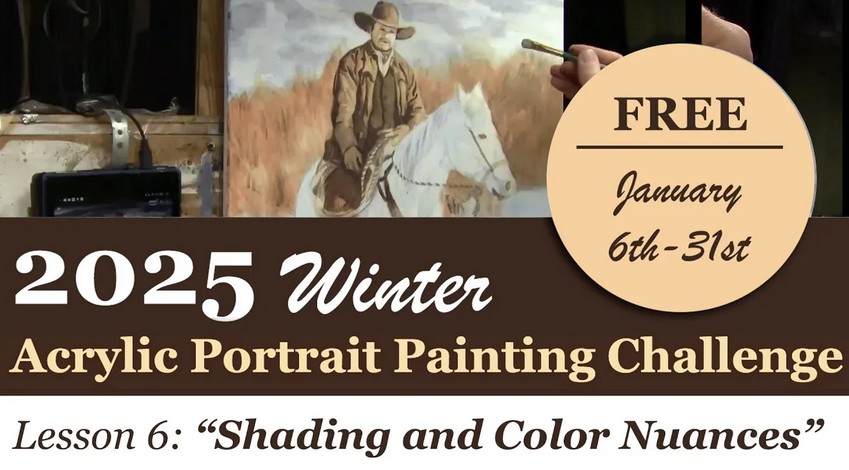
2025 Winter Acrylic Painting Challenge, Lesson 6 Shading and Color Nuances
Shading and color nuances refining depth in your portrait
In this lesson, we focus on refining shading and developing color nuances to bring more depth and realism to our acrylic portrait. By applying glazes strategically, midtones are blended seamlessly, and the transition between highlights and shadows becomes more natural. This technique helps in building the structure of the face, clothing, and background while maintaining smooth tonal gradations.
Before beginning, ensure that your palette is well-prepared. The paints should be moist, making them easier to blend. Using aluminum foil as a mixing surface can provide a fresh start without affecting previous colors.
Recommended Brushes and Materials:
- 1-inch flat brush
- 3/4-inch flat brush
- Round brush (size 5 or 6)
- Matte medium
- Aluminum foil (for palette preparation)
Step 1: Strengthening the Background Contrast
To enhance the overall contrast, the background must be adjusted. This is done by deepening the grass and reeds while subtly refining the hills in the distance.
Mixing the First Glaze:
- Raw umber dark – for depth
- Burnt sienna – to warm up the undertones
- Matte medium – for smooth application
Using a flat brush, apply this glaze in the upper left corner, gradually blending down. Light pressure should be used in some areas to maintain a sense of atmospheric perspective.
Step 2: Adjusting the Right Side with Cooler Tones
To balance out the warmth in the painting, a cooler glaze is introduced.
Mixing the Cool Glaze:
- Raw umber dark – base tone
- Ultramarine blue – cools down the mix
Apply this glaze carefully to the right side, creating a contrast with the warmer reeds on the left. This step ensures variation in color temperature, making the painting feel more dynamic.
Step 3: Developing Mid-tones in Clothing and Facial Features
Now that the background has been balanced, attention shifts to shading the portrait’s clothing and facial features.
Mixing the Midtone Glaze:
- Raw umber dark – primary base
- Burnt sienna – to warm it up
- Titanium white – to introduce opacity
- Raw sienna – softens the transition
Apply this glaze using a round brush in areas that require subtle shading. The transition between shadows and highlights should be gradual. Midtones help define the shape of the jacket, adding depth to folds and creases.
Step 4: Enhancing Contrast with Darker Glazes
To refine the shading and increase contrast, a darker glaze is applied. This helps in defining areas such as:
- The lapel and collar of the jacket
- The brim of the hat
- The creases in the vest and buttons
Mixing the Deep Contrast Glaze:
- Raw umber dark – for depth
- Ultramarine blue – enhances shadows
- Alizarine crimson – adds richness
- Titanium white – to control opacity
Using a detail brush, gently layer this glaze on darker sections, such as the folds of the jacket and the underside of the hat brim. The contrast between these darker areas and the lighter highlights enhances the three-dimensional quality of the portrait.
Step 5: Fine-Tuning Facial Shadows
Shading the face requires a delicate approach to maintain soft transitions. A semi-opaque glaze is mixed using:
- Titanium white – to soften
- Raw sienna – for a warm undertone
- Burnt sienna – adds richness
Apply this glaze to areas such as the shadowed side of the face, beneath the hat, and along the bridge of the nose. Soft strokes ensure the blending appears natural without harsh transitions.
Tips and Techniques for Better Shading and Color Nuances
✅ Use a variety of brushes – Flat brushes are ideal for larger areas, while detail brushes help refine intricate shapes.
✅ Layer gradually – Build up tones slowly rather than applying heavy pigment all at once.
✅ Balance warm and cool tones – A mix of warm browns and cool blues enhances realism.
✅ Keep glazes transparent – Overloading paint can create muddy colors and reduce depth.
✅ Blend softly – Use light pressure when transitioning between tones for a smoother effect.
Incorporating shading and color nuances is crucial for achieving depth in an acrylic portrait. By carefully layering glazes, adjusting midtones, and refining shadows, the painting develops a more lifelike quality. The next lesson will continue refining these details, ensuring the portrait reaches a polished and professional finish.
Would you like to try this technique in your next painting? Share your progress in the Realistic Acrylic Portraits Facebook Group and join fellow artists in the 2025 Winter Acrylic Painting Challenge!
🔹 Join the challenge today: RealisticAcrylic.com
Frequently Asked Questions (FAQs)
1. Why is shading and color nuance important in portrait painting?
Shading creates depth, while color nuances ensure natural transitions between highlights and shadows, making the portrait look more realistic.
2. How do I avoid a chalky appearance when adding highlights?
Mix titanium white with raw sienna or burnt sienna to balance opacity and warmth. Applying too much white alone can make highlights look unnatural.
3. What is the best way to control glaze transparency?
Using matte medium ensures that glazes remain translucent. Adjust the paint-to-medium ratio depending on how strong or subtle you want the effect.
4. How many layers of glazing should be applied?
Multiple thin layers should be applied rather than a single thick one. This method allows for better control over color depth and smooth transitions.
5. Can I use a hairdryer to speed up drying between layers?
Yes, but use a low heat setting to avoid cracking or warping the paint.
2025 Winter Acrylic Portrait Painting Challenge Series
2025 Winter Acrylic Portrait Painting Challenge: Steps to Get Started
2025 Winter Acrylic Portrait Challenge Pre-Lesson: Gathering Your Supplies
2025 Winter Acrylic Portrait Challenge, Lesson 1: Prepping Your Canvas for the Portrait
2025 Winter Acrylic Painting Challenge, Lesson 2: Sketching Your Portrait Accurately
2025 Winter Acrylic Painting Challenge, Lesson 3: Sealing in Your Sketch
2025 Winter Acrylic Painting Challenge, Lesson 4: Beginning Your Portrait with Glazes
2025 Winter Acrylic Painting Challenge, Lesson 5: Building Up Color and Contrast
2025 Winter Acrylic Painting Challenge,Bonus Video: Increasing Contrast

2025 Winter Acrylic Painting Challenge,Bonus Video: Increasing Contrast
Master the art of increasing contrast in your acrylic portraits with simple glazing techniques
In this bonus session of the 2025 Winter Acrylic Painting Challenge, we focus on an essential stepincreasing contrast to create more depth and realism. By building up layers and refining shadows, we can bring out key elements in the portrait before moving into the next lesson.
Why Contrast Matters in Acrylic Painting
Contrast is one of the fundamental principles that makes a painting stand out. It helps define the subject, create a sense of depth, and guide the viewer’s eye. Without proper contrast, an image may appear flat or lifeless.
In this lesson, the focus is on:
- Strengthening shadows and highlights
- Refining shapes with precise brushwork
- Using glazing techniques for smooth transitions
Materials Used
- Raw Umber Dark
- Ultramarine Blue
- Alizarine Crimson
- Titanium White
- Raw Sienna
- Matte Medium
- Round Detail Brush (Size 2)
- Flat Brush (1/4 inch)
Step-by-Step Process for Increasing Contrast
1. Adding Definition to Clothing and Accessories
The first area of focus is the clothing, particularly the buttons and fabric folds. To prevent losing the details, a light mixture of titanium white and raw sienna is applied to the buttons. This ensures they remain visible even after additional layers of paint are added.
- Mix titanium white with raw sienna for an opaque highlight.
- Apply it in thin, controlled strokes to emphasize the button edges.
- Allow the layer to dry before applying additional glazes.
2. Applying a Glaze for Deeper Shadows
To create a darker value for the clothing shadows, a glaze is prepared using raw umber dark, ultramarine blue, and a touch of alizarine crimson mixed with matte medium.
- This mixture is semi-translucent, allowing previous layers to remain visible.
- It is applied to the edges of the clothing and negative spaces between elements.
- A smooth gradient is achieved by feathering out the edges with a dry brush.
3. Refining Shadows in Facial Features
To make the face more three-dimensional, subtle shadows are introduced under the hat brim, around the eyes, and along the mustache and beard.
- A smaller detail brush is used for precision.
- A glaze mixture similar to the clothing shadows is applied in thin layers.
- The darkest areas are carefully deepened while still allowing for soft transitions.
4. Enhancing the Background and Rope Details
The negative space behind the subject is darkened to make the foreground stand out. Additionally, the ropes and scarf details are defined by using precise brush strokes.
- A darker glaze is applied to the background while maintaining soft edges.
- The spaces between the ropes are carefully shaded to enhance contrast.
- Layering shadows on the scarf creates a sense of texture and folds.
Tips for Mastering Contrast in Acrylic Painting
✔ Use a Limited Palette for Shadows: Mixing complementary colors rather than using straight black results in more natural-looking shadows.
✔ Work from General to Specific: Begin with broad shadow areas before refining small details.
✔ Layer Gradually: Instead of applying dark paint all at once, build it up in thin layers to control the intensity.
✔ Utilize Soft and Hard Edges: Hard edges emphasize details, while soft edges create depth and natural transitions.
✔ Check Your Painting in Black and White: Viewing your work in grayscale helps assess contrast levels effectively.
By following these steps and gradually increasing contrast, your painting will gain a greater sense of realism. Whether you are working on clothing, facial features, or background elements, strategic contrast adjustments can make all the difference.
Keep practicing, and don’t be afraid to layer and refine your shadows! What part of contrast enhancement do you find most challenging? Let’s discuss in the comments below.
🚀 Stay tuned for the next lesson in the 2025 Winter Acrylic Painting Challenge! Don’t forget to join my Facebook group, where I post update for the next lessons.
Frequently Asked Questions: Increasing Contrast in Acrylic Painting
Q: Why does my painting still look flat even after adding shadows?
A: The issue might be the lack of balance between shadows and highlights. Try increasing contrast in both areas by brightening highlights and deepening shadows gradually.
Q: How many layers should I use for proper contrast?
A: This depends on the opacity of your paint. Glazing techniques require multiple thin layers, while more opaque applications may need fewer.
Q: How can I blend shadows smoothly in acrylic painting?
A: Using matte medium or water can help create smoother transitions. Also, working while the paint is still wet allows for better blending.
2025 Winter Acrylic Portrait Painting Challenge Series
2025 Winter Acrylic Portrait Painting Challenge: Steps to Get Started
2025 Winter Acrylic Portrait Challenge Pre-Lesson: Gathering Your Supplies
2025 Winter Acrylic Portrait Challenge, Lesson 1: Prepping Your Canvas for the Portrait
2025 Winter Acrylic Painting Challenge, Lesson 2: Sketching Your Portrait Accurately
2025 Winter Acrylic Painting Challenge, Lesson 3: Sealing in Your Sketch
2025 Winter Acrylic Painting Challenge, Lesson 4: Beginning Your Portrait with Glazes
2025 Winter Acrylic Painting Challenge, Lesson 5: Building Up Color and Contrast
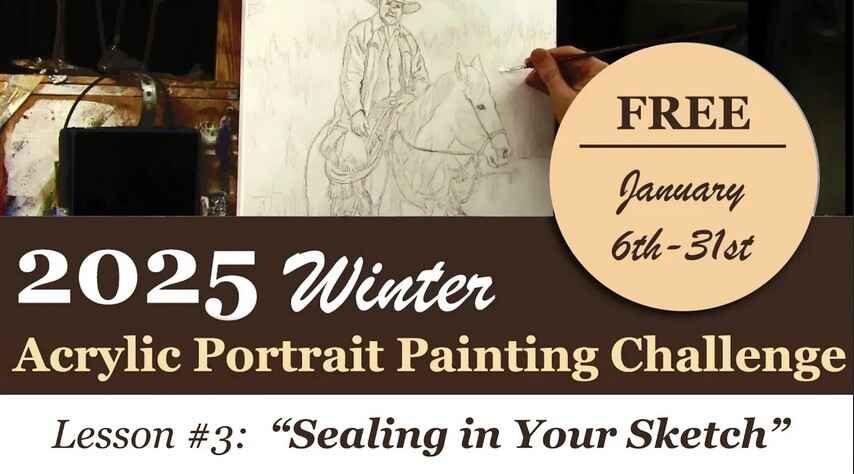
2025 Winter Acrylic Painting Challenge, Lesson 3: Sealing in Your Sketch
Preserving your sketch: A step-by-step guide to starting your acrylic painting with confidence
When embarking on an acrylic painting journey, especially for a portrait or complex composition, a strong foundation is critical. That’s where sealing in your sketch comes into play. In this lesson from the 2025 Winter Acrylic Portrait Painting Challenge, we’ll cover a detailed, beginner-friendly guide on how to preserve your sketch while setting the stage for vibrant and confident painting.
The keyword? Confidence. When your sketch is securely sealed, you’ll paint with ease and precision. Let’s dive into the four-step process that ensures your hard work is protected and ready for layers of color and depth.
Why Sealing in Your Sketch Matters
Your sketch serves as the blueprint of your painting. Without proper sealing, colored pencil marks can smudge or bleed into subsequent layers, disrupting the clarity of your design. Sealing provides a protective barrier, ensuring the sketch remains intact and your painting proceeds without setbacks.
Step-by-Step Guide to Sealing in Your Sketch
Step 1: White Out the Grid
Start by addressing the grid lines. These guide initial proportions but should not remain visible in the final painting.
- Why Use Titanium White Instead of Gesso?
Titanium white paint provides opacity without translucence, unlike gesso. It effectively covers grid lines while maintaining a smooth finish. - What You’ll Need:
- Titanium white paint
- Three brushes: a medium-sized flat brush, a small flat brush, and a small round brush
- Disposable mini cups or a small container for the paint
Process:
- Dip your larger flat brush into titanium white paint.
- Apply it over the grid lines, smoothing the brushstrokes for an even finish.
- Switch to smaller brushes for tighter areas, such as the details near edges and inside lighter value zones.
- Cover grid lines within illuminated areas and transitions like snow tracks or delicate highlights.
Pro Tip: Use firm pressure to cut around intricate details while avoiding overlap with the sketch.
Step 2: Spray Seal the Canvas
Once the grid lines are covered and the titanium white layer has dried completely (allow a few hours for thorough drying):
- Use a clear acrylic spray sealant to lock in the sketch.
- Hold the spray can about 12 inches away from the canvas for an even application.
This step prevents smudging while adding a layer of protection.
Step 3: Brush Seal the Canvas
For added durability, brush seal the canvas after the spray sealant has dried.
- Use a soft, wide brush and a thin coat of matte medium or glazing medium.
- Gently apply in smooth, even strokes, avoiding bubbles or uneven texture.
Allow the canvas to dry fully before proceeding to the next step.
Step 4: Begin Layer One of Painting
With the sketch sealed, it’s time to add your first layer of color. This layer will establish the foundational tones and values, setting the stage for depth and detail in subsequent layers.
- Focus on broad, general areas first, keeping the colors light and translucent.
- Use glazing techniques to gradually build intensity without losing the clarity of your sketch.
Tips for a Smooth Sealing Sketch
- Patience Is Key: Ensure each layer dries thoroughly before moving to the next. This prevents smearing and uneven finishes.
- Use Quality Materials: High-quality titanium white and sealants make a significant difference in coverage and durability.
- Practice Makes Perfect: If you’re new to sealing techniques, practice on a small test canvas before working on your main piece.
Sealing in your sketch is an indispensable step in acrylic painting. By following this four-step process, you’ll create a robust foundation for your artwork, ensuring your sketch remains intact and ready to support vibrant layers of paint.
For more guidance, including reference materials, supply lists, and exclusive painting challenges, watch the video tutorial below and join the 2025 Winter Acrylic Portrait Painting Challenge at www.realisticacrylic.com. It’s free and packed with resources to elevate your painting skills.
Now it’s your turn! Get your brushes, titanium white, and sealants ready, and seal in your sketch with confidence. Don’t forget to join my Facebook community that a lot of artist support each other. Happy painting!
2025 Winter Acrylic Portrait Painting Challenge Series
2025 Winter Acrylic Portrait Painting Challenge: Steps to Get Started
2025 Winter Acrylic Portrait Challenge Pre-Lesson: Gathering Your Supplies
2025 Winter Acrylic Portrait Challenge, Lesson 1: Prepping Your Canvas for the Portrait
2025 Winter Acrylic Painting Challenge, Lesson 2: Sketching Your Portrait Accurately

2025 Winter Acrylic Painting Challenge, Lesson 2: Sketching Your Portrait Accurately
Master the art of sketching your portrait accurately: techniques for precision and detail
Creating a stunning acrylic portrait begins with one fundamental skill: sketching your portrait accurately. Whether you’re a beginner or an experienced artist, mastering this foundational step ensures that your final painting shines with realism and precision.
In this blog post, we’ll dive into the process of accurate sketching, covering essential tools, techniques, and tips to help you bring your artistic vision to life.
Why Accurate Sketching is Key
Accurate sketching lays the groundwork for a successful painting. Without it, even the most vibrant colors and refined brushstrokes can’t save a portrait from looking unbalanced or disproportionate.
Sketching ensures:
- Proper proportions and anatomy.
- Consistent composition.
- A clear guide for painting details.
Tools You Need for Sketching
Before starting your sketch, gather the right tools to make the process smoother:
- Canvas: Prepare your canvas with a layer of matte medium and gesso for a smooth base.
- Colored Pencils: Use a dark brown Prismacolor pencil for precise marks. Colored pencils are easier to erase and smear less than graphite.
- Erasers: White erasers or battery-operated erasers help make clean corrections.
- Grid Reference Photo: Print a photo with a grid overlay to maintain accuracy.
Step-by-Step Guide to Sketching Your Portrait
1. Prepare Your Canvas and Grid
- Start with a clean canvas that has been sanded and coated with gesso and matte medium.
- Apply a grid using light-colored pencils. Ensure the grid matches the one on your reference photo for easy alignment.
2. Mark Key Outlines
Begin by marking the rough outlines of the subject:
- Focus on large shapes first, such as the head, torso, and background elements.
- Use your grid to locate where features intersect horizontal and vertical lines.
3. Measure Proportions with Fractions
Observe how features align within the grid:
- For example, if a leg or arm intersects halfway through a square, mark it accordingly.
- Visualize proportions instead of rigidly plotting points to maintain fluidity in your sketch.
4. Add Fine Details
Once the main outlines are in place:
- Begin adding finer details such as facial features, clothing folds, and accessory edges.
- Stay consistent with the grid to avoid distortions.
5. Adjust and Refine
Make adjustments as needed:
- Erase and redraw areas that seem off.
- Use your eraser to clean smudges and maintain sharp lines.

Tips for Sketching Success
- Stay Loose: Avoid rigid lines early on. Keep your sketch fluid and adaptable.
- Use References: Double-check proportions and angles with your reference photo.
- Take Breaks: Step away from your sketch periodically to view it with fresh eyes.
- Pray for Focus: If you’re a faith-driven artist, a moment of prayer or meditation can provide clarity and inspiration.
Filling in Features Loosely
After outlining the portrait, the next step is to fill in the interior features loosely. This stage is all about blocking in shapes and establishing the basic elements of the composition. Here’s how to proceed:
- Sharpen Your Pencil
Use a sharpened pencil for better control and detail as you work on filling in the interior parts. - Start With Large Shapes
Begin sketching the major features, such as the shape of the head, edges of clothing, or other significant elements. For example:- Sketch the edges of hats, saddles, and other accessories if your subject involves detailed attire.
- Use short, choppy strokes to add features like arms or folds in fabric.
- Erase as Needed
Keep a light hand while sketching so that any adjustments can be made easily. Wax-based colored pencils, such as Prismacolor, are ideal because they erase cleanly and don’t smear when sealed. - Avoid Over-Detailing
At this stage, resist the temptation to focus on intricate details. Instead, concentrate on the overall shapes and their placement. For instance:- Block in the basic contours of the face and torso.
- Mark the positions of hands and fingers, but keep them rough.
Tools for Success
- Choose the Right Materials: Always use wax-based colored pencils for sketching. Avoid watercolor pencils, as they can smear during sealing.
- Leverage the Grid Method: Utilizing a grid helps maintain accurate proportions. Match your lines and shapes with the corresponding grid sections for precise placement.
Using Negative Space for Accuracy
One of the most powerful techniques in “Sketching Your Portrait Accurately” is analyzing negative space. Negative space refers to the areas around and between the subject of your sketch. Here’s how to use it effectively:
- Look for small shapes created by the intersections of your grid lines and subject.
- Compare these shapes to the reference image to ensure accuracy.
- Use these shapes as a guide to correct the positioning of features like eyes, hands, or accessories.
For example, if you’re drawing a strap or a buckle, observe how its placement aligns with the grid lines and creates unique negative shapes. Adjust your sketch as needed to match these shapes.
Common Mistakes to Avoid
- Ignoring Proportions: Ensure your subject’s proportions are correct, such as the width of arms or the placement of facial features.
- Overthinking Shapes: Focus on drawing what you see rather than what you think something should look like. Break complex elements into simple geometric shapes for better accuracy.
- Rushing to Details: Prioritize accurate blocking before refining.
Refining and Adding Detail
Once your loose sketch is complete, the next phase is refinement. Tighten the lines, enhance the details, and bring your subject to life. This includes:
- Adding intricate features like facial expressions, folds in clothing, or textures.
- Refining shapes based on feedback from the negative space analysis.
- Layering details to create depth and realism.
Why Accuracy Matters in Sketching
Accuracy in sketching sets the tone for the entire painting process. A well-proportioned sketch allows you to focus on colors, tonal values, and textures during painting. By mastering “Sketching Your Portrait Accurately,” you ensure your artwork resonates with realism and precision.
FAQ About Sketching Your Portrait Accurately
1. Can I use graphite pencils instead of colored pencils?
Yes, but colored pencils are recommended. They erase more cleanly and smear less, especially on a prepared canvas.
2. How do I align my grid correctly?
Ensure your grid matches your reference photo precisely. Double-check measurements and offsets before sketching.
3. How detailed should my sketch be?
Focus on capturing key proportions and outlines. Save intricate details for later stages of painting.
4. What if I make a mistake?
Use a good-quality eraser to make corrections. If your canvas preparation is solid, you can easily adjust your sketch without damaging the surface.
Take the first step today, and don’t forget to check out our Acrylic Portrait Painting Challenge and sign up here. It’s free to join, and you’ll get everything you need to create a masterpiece!
2025 Winter Acrylic Portrait Painting Challenge Series
2025 Winter Acrylic Portrait Painting Challenge: Steps to Get Started
2025 Winter Acrylic Portrait Challenge Pre-Lesson: Gathering Your Supplies
2025 Winter Acrylic Portrait Challenge, Lesson 1: Prepping Your Canvas for the Portrait

2025 Winter Acrylic Portrait Challenge, Lesson 1: Prepping Your Canvas for the Portrait
Master the art of prepping your canvas for a smooth and successful portrait painting
In this first lesson of our Winter Acrylic Portrait Challenge Masterclass, we will dive into the crucial process of prepping your canvas for the portrait. Whether you are a seasoned artist or a beginner, taking the time to properly prepare your canvas for the portrait that will ensure that your painting has a solid foundation for detailed and lifelike results.
Step 1: Setting Up Your Canvas
Before diving into the painting process, it is important to ensure that your canvas is in good shape. Start by setting up your canvas firmly on the easel. In our challenge, we are using a 16×20 canvas, which is a great size for portraits. When setting up your canvas, always check the square corners with a square tool or simply by eye. You should also inspect the canvas from the side to make sure it’s not bowed or distorted.
If you notice any bumps or dents, don’t worry this is a common issue, especially if your canvas has been stored for a while. These minor imperfections can be easily corrected.
Step 2: Fixing Wrinkles and Dents
Sometimes, after a canvas is unwrapped from its packaging, wrinkles or dents can appear. A simple solution for this is to lightly mist the back of your canvas with water. Use a spray bottle or mister to ensure that the entire back is saturated, especially in the corners. After spraying, let the canvas dry completely either by hanging it up or allowing it to air dry. This step is crucial because it tightens the fabric and eliminates any imperfections, leaving you with a taut and smooth canvas that will be perfect for painting.
Step 3: Applying Gesso for a Smooth Surface
Now, let’s move on to the critical step of applying gesso. Even though most canvases come pre-primed, the primer they use is often too thin to create a smooth and rigid surface. By applying gesso, you add a thicker coat that not only improves the rigidity of your canvas but also provides a smoother texture ideal for detailed painting.
Gesso also makes your canvas more archival, ensuring that your artwork will stand the test of time. For this lesson, we will be applying a custom mix of gesso and matte medium. To start, pour the gesso into a small container. You will need a condiment container or small disposable cup for this task. Add about 50% gesso and 50% matte medium. The matte medium will help to thin the gesso, allowing it to be applied more smoothly while also ensuring that the surface is perfect for sketching.

Step 4: Stirring the Mixture
Once you have your gesso and matte medium in your container, stir the mixture thoroughly with an old brush or a stirring stick. The goal is to ensure that the two components blend together to form a smooth and consistent mixture. A 50/50 ratio works well, but feel free to adjust depending on the desired consistency. The matte medium will not only improve the application of the gesso but also create an ideal surface for sketching, allowing your colored pencils to adhere better.
Step 5: Applying the Gesso Mixture
Now it’s time to apply the gesso mixture to your canvas. Using a brush, evenly coat the surface with the gesso. Work in smooth, gentle strokes to cover the entire canvas. You should aim for an even layer that is not too thick or thin. Be sure to cover the edges of the canvas as well. Once applied, allow the gesso to dry completely before proceeding to the next steps of your painting process.
Properly prepping your canvas is a fundamental step in achieving a high-quality portrait painting. With the right techniques, such as checking for squareness, fixing wrinkles, and applying a smooth gesso layer, you are setting yourself up for success. By following these steps, you can ensure that your painting will have a strong foundation for detailed and accurate portrait work.
In this first lesson, we have set the stage for an exciting and rewarding painting experience. As you progress through this Winter Acrylic Portrait Challenge, continue to refer back to these preparation steps for each new portrait you tackle. With every layer and brushstroke, your painting will come to life, and you’ll be proud of the portrait you’ve created. Keep practicing, and don’t hesitate to ask for support from the community together, we can achieve beautiful portraits!
By prepping your canvas properly, you are taking the first step toward a successful portrait painting. Join us for the full Winter Acrylic Portrait Challenge and start creating the portrait of your dreams today! Pre-Lesson: Gathering Supplies
To know more watch my video tutorial below.

2025 Winter Acrylic Portrait Challenge Pre-Lesson: Gathering Your Supplies
Master the art of acrylic portraits: Start with the right supplies for the winter challenge
Welcome to the Challenge
The Winter Acrylic Portrait Challenge Masterclass is here, and this pre-lesson sets the stage for a transformative artistic journey. Whether you’re a seasoned painter or new to acrylics, this challenge will help you develop your skills and create a stunning winter portrait. Let’s dive into the essential supplies and steps to ensure your success.
What Makes This Challenge Special?
This is the first-ever Winter Acrylic Portrait Challenge, a unique opportunity to explore the beauty of acrylic portraiture in a winter theme. Past challenges have inspired thousands of artists to push their boundaries, with many creating portraits for the first time. This challenge builds on that success, offering you a step-by-step guide and a supportive community.
Why Should You Join?
If you haven’t signed up yet, now is the time! Joining the challenge grants you access to:
- A Welcome Kit: A detailed guide with everything you need to participate.
- Step-by-Step Lessons: Video tutorials that simplify complex techniques.
- Supportive Community: Engage with fellow artists, share progress, and seek guidance.
Sign up today ➡️ https://realisticacrylic.com/acrylic-portrait-painting-challenge/
Supplies You’ll Need
Gathering the right materials is the first step. Here’s a checklist to get you started:
- Acrylic Paints: A basic set including primary colors, white, black, and earth tones.
- Brushes: A variety of sizes, including round, flat, and detail brushes.
- Canvas or Hardboard: A primed surface for your artwork.
- Palette: Preferably with wells to keep colors clean and organized.
- Reference Photo: Included in the welcome kit – a horse and rider in the snow.
- Other Essentials: A water container, paper towels, and a palette knife.
The welcome kit also provides a palette layout guide, ensuring your colors stay vibrant and unmuddied during mixing.
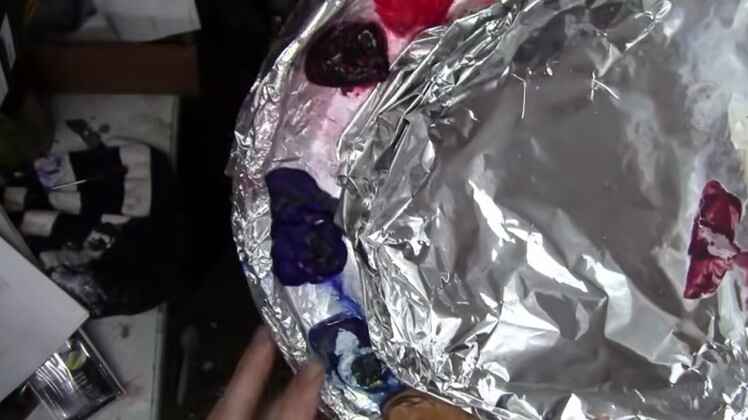
The Power of Community
Participating in this challenge means joining a community of like-minded artists. Share your progress on social media or the exclusive Facebook group, where you’ll receive feedback, encouragement, and tips to overcome challenges.
The Importance of Faith in Art
Throughout the challenge, you’ll be reminded that creativity is a gift. Trust in your abilities and the guidance provided. With persistence, support, and faith, you can create a portrait to be proud of.
Step-by-Step Guidance for Success
The masterclass lessons will guide you through:
- Sketching your portrait using grids for accuracy.
- Layering and blending techniques for depth and realism.
- Overcoming common struggles with acrylics.
If you feel stuck, reach out to the community or re-watch the tutorials for clarity.
A Final Word of Encouragement
The Winter Acrylic Portrait Challenge is more than a painting class; it’s an opportunity to grow, connect, and inspire others with your art. Whether this is your first portrait or your tenth, you’ll finish the challenge with newfound confidence and skills.
Take the First Step
Don’t let hesitation hold you back. Gather your supplies, sign up, and embark on this incredible artistic journey. You’ll be amazed at what you can achieve.
Let’s paint something extraordinary together

2025 Winter Acrylic Portrait Painting Challenge: Steps to Get Started
Learn to paint a winter scene with a rider and horse using acrylics: Free masterclass for all skill levels!
The new year brings a fresh opportunity to elevate your artistic journey with the 2025 Acrylic Portrait Painting Challenge. Running from January 6th to January 31st, this free challenge invites artists of all skill levels to explore the world of acrylic portraiture. Whether you’re a seasoned painter or just starting out, this masterclass series provides step-by-step guidance to help you craft a breathtaking winter scene featuring a rider on a horse in the snow.
The 2025 Acrylic Portrait Painting Challenge is here to help you grow as an artist while connecting with a community of like-minded creators. This free challenge offers everything you need to create a stunning acrylic portrait . And also you will discover how to sign up, receive your free welcome kit, and begin your artistic journey with me. Let’s dive into the details!
What Is the 2025 Acrylic Portrait Painting Challenge?
The challenge is a free opportunity for artists to learn acrylic portrait painting through structured lessons and community support. Participants will gain access to a detailed welcome kit and exclusive tutorials that guide them step by step.
By signing up, you will paint along with other artists worldwide and improve your skills in creating realistic portraits.
What’s Included in the Welcome Kit?
When you sign up, you’ll receive a comprehensive welcome kit that contains:
- Overview Guide: A document outlining the challenge’s structure and objectives.
- Supplies List: A detailed list of materials, including brushes, paints, and canvas sizes.
- Palette Layout Guide: Instructions for arranging your paints to ensure optimal color mixing.
- Reference Photo: An 8×10 reference image, along with a gridded version for precise sketching.
- Master Class Schedule: A lesson schedule detailing the topics covered throughout the challenge.
This kit ensures that you are fully prepared to paint alongside the lessons.
How to Sign Up for the Challenge
Signing up for the 2025 Acrylic Portrait Painting Challenge is simple and completely free. Follow these steps:
- Visit the official sign-up page: realisticacrylic.com/acrylic-portrait-painting-challenge.
- Fill out your first and last name, as well as your email address.
- Click the “Send Me the Welcome Kit” button.
- Check your email for the registration confirmation and further instructions.
Once registered, you will receive a downloadable PDF welcome kit. It is recommended to save or print it for easy access during the challenge.
Benefits of Joining the Challenge
- Learn at Your Own Pace: Access seven to eight lessons, covering every step of creating a realistic acrylic portrait.
- Community Support: Join a private Facebook group to connect with other participants, share progress, and seek feedback.
- Step-by-Step Guidance: Follow structured tutorials that simplify complex techniques.
Frequently Asked Questions
Q: Is the challenge free to join?
A: Yes, the challenge is completely free, and you can sign up at any time.
Q: Do I need prior painting experience?
A: No prior experience is required. The lessons cater to artists of all skill levels.
Q: What supplies will I need?
A: A supplies list is included in the welcome kit, detailing brushes, paints, and canvas sizes.
Q: Can I download the welcome kit to my phone?
A: Yes, the PDF file can be downloaded to your phone, tablet, or computer.
Q: Can I access the lessons later if I miss the live session?
A: Yes, the lessons will be available to view on demand.
Q: How can I connect with the artist community?
A: You’ll gain access to an exclusive online group where you can share progress, ask questions, and receive feedback. Join my Facebook Group now: Realistic Acrylic Portraits
Tips for a Successful Challenge Experience
- Save the welcome kit to your device for easy access.
- Print the materials to keep them organized and within reach.
- Participate in the Facebook group for support and motivation.
- Star or mark challenge-related emails as important to avoid missing updates.
- Share the challenge with artist friends to enjoy the experience together.
The 2025 Acrylic Portrait Painting Challenge is your chance to develop your portrait painting skills while enjoying the camaraderie of a supportive artistic community. Signing up is easy, and the welcome kit ensures you are fully prepared to participate.
Join us today and take the first step toward creating a masterpiece. Don’t wait, sign up now and grab the opportunity to transform a blank canvas into a masterpiece. Whether you’re painting to create a heartfelt gift, sharpen your skills, or express yourself. This Free Portrait Painting Challenge is the perfect place to start with.

How to Achieve Contrast in Facial Features Using Glazing Techniques
Unlock the power of glazing techniques to create stunning depth and realism in facial features
Creating lifelike contrast in facial features is an essential skill for any portrait artist, especially when working with acrylics. By using glazing techniques, you can add depth, refine shadows, and bring out details that elevate the realism of your paintings. This guide will walk you through how to use glazing to create dynamic contrasts in the facial features, ensuring your portraits are more vibrant and visually striking.
What is Glazing in Acrylic Painting?
Glazing is a technique that involves layering thin, transparent layers of paint over a dry underpainting. This allows you to build up rich tones and fine details without altering the structure of the layers beneath. By adjusting the intensity of the glaze, you can manipulate the contrast between light and dark areas of your painting.
Why Contrast Matters in Portraits
Contrast is key to achieving a realistic portrait. It’s the difference between the lightest and darkest areas that define the contours and features of the face. Without strong contrast, the face can appear flat and lifeless. Glazing techniques allow artists to enhance this contrast gradually, creating a more three-dimensional look.
Steps to Achieve Contrast in Facial Features Using Glazing
1. Prepare Your Base Layer
Start by creating a well-defined underpainting with an appropriate mid-tone value. This will serve as the foundation for your glazes. Make sure this layer is fully dry before you begin applying any glazes.
2. Apply Initial Glaze to Dark Areas
Begin with your darkest areas, such as the hairline, eyebrows, and shadows around the eyes. Mix a transparent layer of paint using a dark color like raw umber or burnt sienna. Add a glazing medium to make the paint transparent and apply it over the underpainting.
3. Refining Facial Features
For the nose, chin, and cheekbones, observe the natural contours and apply glazes to enhance the depth. Focus on adding subtle shadow variations by layering transparent colors. These will blend with the underpainting, creating a smooth transition from light to dark.
4. Layering to Increase Contrast
Once your first glaze is dry, apply subsequent layers to build up more contrast. Use lighter glazes for areas like the forehead, tip of the nose, and under the eyes. A combination of titanium white and yellow ochre can be used for highlights. This gradual layering process allows the colors to meld seamlessly, creating a rich contrast.
5. Detailing with Fine Glazes
For fine details like the texture of the skin, eyelids, and lips, you can use a more delicate glaze. Use a fine-tipped brush to add lighter tones on the skin’s surface or a darker glaze to intensify shadows around the jawline or under the nose. The key is to maintain a balance between light and dark to keep the face looking natural.
6. Final Refinements
After several layers, evaluate your painting to see if additional contrast is needed. Add glazes to areas where shadows may need to be deepened or highlights need to be accentuated. Blend the glazes smoothly to avoid harsh lines and ensure that all features have a harmonious depth.
Tips and Techniques for Perfecting Contrast with Glazing
- Use a Slow-Drying Medium: A slow drying medium allows you more time to manipulate your glazes before they set. This can be particularly helpful for blending.
- Thin Layers are Key: Thin, transparent layers allow the underlying colors to show through, giving your portrait more dimension. Avoid thick, opaque layers as they can overpower the underpainting.
- Pay Attention to Light Source: Always keep the light source in mind. Shadows will fall in different places depending on the position of the light. This will determine where you apply your darker glazes.
- Use Complementary Colors for Contrast: Using complementary colors, like mixing greens with reds or blues with oranges, can create dynamic contrast, making your facial features pop.
Common Mistakes to Avoid
- Over-applying Glaze: Too many glazes can obscure the fine details of your portrait. Be patient and build layers gradually.
- Not Allowing Layers to Dry: Glaze should always be applied to a dry layer to avoid muddiness. Always allow each layer to fully dry before adding another glaze.
- Not Using Enough Contrast: It’s easy to understate contrast in portraits, especially when using glazes. Make sure your darkest darks and lightest lights are well represented.
Achieving contrast in facial features using glazing techniques is an essential skill that can bring your acrylic portraits to life. By applying thin layers of transparent paint, you can build up depth, highlight details, and enhance the three-dimensionality of your subject. With patience and careful attention to light and shadow, you can master this technique and elevate your portrait painting to new levels of realism.
Remember, contrast is about balance too little, and your painting will look flat; too much, and it can appear harsh. With glazing, you have the perfect tool to control this balance, creating a beautifully nuanced and realistic portrait.
If you’re looking for more instructional videos on how to improve your acrylic painting, visit www.realisticacrylic.com for more tutorials and check out my free courses here.
Frequently Asked Questions (FAQ)
Q: How many layers of glaze should I apply?
A: The number of layers depends on the depth you want to achieve. Typically, three to five layers work well for creating noticeable contrast.
Q: Can I use glazing on all parts of the face?
A: Yes, glazing can be applied to all parts of the face, including the eyes, nose, lips, and hair. It’s especially effective for adding depth to areas like the eye sockets and the jawline.
Q: What type of glaze medium is best for portraits?
A: An acrylic glazing medium is best for portraits, as it allows for smooth application and transparency. Avoid using heavy mediums that may make the paint too thick.
Q: Do I need to use dark glazes for shadows?
A: Dark glazes work well for deep shadows, but you can also use mid-tones or neutral colors. The goal is to create a gradual transition from light to dark, not to create harsh, artificial shadows.
Tips for Achieving Contrast in Facial Features:
- Apply thin layers of glazes to gradually build depth.
- Focus on the light source to guide your application of glazes.
- Experiment with complementary colors for stronger contrast.
- Allow each glaze layer to dry before adding another for smooth blending.
LEARN MORE
- Sketching Your Painting Accurately
- Beginning a Pet Portrait in Acrylic
- The Mystery of Realism in Painting
- Apply A Burnt Sienna Glaze to a Portrait
- Learn How to Sketch a Portrait Freehand in 45 Minutes
- Adding highlights to your acrylic painting
- 5 Excellent Reasons to Use Aluminum Foil
- Paint Realistic Wrinkles in Acrylic
- Painting Clothing in an Acrylic Portrait
- Paint a Cloudy Sky Acrylic
- How to add Semi-Opaque Highlights
- How to Enhance the Contrast in Your Acrylic
- How to Add Glaze to Your Acrylic Painting
- Paint Realistic Reflections on Eyeglasses in an Acrylic Portrait
- Build Up Depth on Your Acrylic Portrait Backgrounds
- How Do You Do Layers With the Glazing Technique?
- Learn How to Paint Wrinkles in Acrylic
Read more about how to paint a portrait that you can surely be proud of!
I’d love to hear your thoughts on this video. Please share it with your friends and family. Let me know if you have any further questions. I’ll greatly help you.
If you’d like to learn more, sign up for my free email tips and video class today.
Learn How to Paint Acrylic Portraits With My Free Mini-Video Course!Thank you so much for taking the time to read this tutorial and watch the video. That means a lot to me. I hope you find it very helpful in your portrait painting.
Yours for Better Portraits,

P.S. Did you find this post helpful or encouraging? If so, send it in ahead! Let others know with the share buttons below. I’d love to hear your comments. Thank you so much! Also, do you have a question on acrylic portrait painting you’d like answered? Let me know, and I’d be happy to help!
